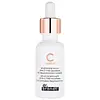What's inside
What's inside
 Key Ingredients
Key Ingredients

 Benefits
Benefits

 Concerns
Concerns

 Ingredients Side-by-side
Ingredients Side-by-side

Water
Skin ConditioningPropylene Glycol
HumectantLecithin
EmollientAlcohol
AntimicrobialPolymethyl Methacrylate
PEG-40 Hydrogenated Castor Oil
Emulsifying4-Butylresorcinol
AntioxidantAscorbyl Glucoside
AntioxidantRetinol
Skin ConditioningAzelaic Acid
BufferingNiacin
SmoothingUndecylenoyl Phenylalanine
Skin ConditioningGlycyrrhetinic Acid
Skin ConditioningMorus Alba Root Extract
BleachingDiacetyl Boldine
Skin ConditioningPEG/PPG-20/6 Dimethicone
EmulsifyingSodium Cholate
Skin ConditioningPolysorbate 20
EmulsifyingXanthan Gum
EmulsifyingCarbomer
Emulsion StabilisingTriethanolamine
BufferingTocopheryl Acetate
AntioxidantBHT
AntioxidantSodium Hydroxide
BufferingCaprylic/Capric Triglyceride
MaskingSodium Chloride
MaskingHydroxypropyl Cyclodextrin
MaskingBHA
AntioxidantPentaerythrityl Tetra-Di-T-Butyl Hydroxyhydrocinnamate
AntioxidantTriisopropanolamine
BufferingHydrochloric Acid
BufferingPhenoxyethanol
PreservativeEthylhexylglycerin
Skin ConditioningParfum
MaskingCitronellyl Methylcrotonate
MaskingCitral
PerfumingCoumarin
PerfumingEugenol
PerfumingLimonene
PerfumingIsoeugenol
PerfumingWater, Propylene Glycol, Lecithin, Alcohol, Polymethyl Methacrylate, PEG-40 Hydrogenated Castor Oil, 4-Butylresorcinol, Ascorbyl Glucoside, Retinol, Azelaic Acid, Niacin, Undecylenoyl Phenylalanine, Glycyrrhetinic Acid, Morus Alba Root Extract, Diacetyl Boldine, PEG/PPG-20/6 Dimethicone, Sodium Cholate, Polysorbate 20, Xanthan Gum, Carbomer, Triethanolamine, Tocopheryl Acetate, BHT, Sodium Hydroxide, Caprylic/Capric Triglyceride, Sodium Chloride, Hydroxypropyl Cyclodextrin, BHA, Pentaerythrityl Tetra-Di-T-Butyl Hydroxyhydrocinnamate, Triisopropanolamine, Hydrochloric Acid, Phenoxyethanol, Ethylhexylglycerin, Parfum, Citronellyl Methylcrotonate, Citral, Coumarin, Eugenol, Limonene, Isoeugenol
Water
Skin ConditioningTetrahexyldecyl Ascorbate
AntioxidantC9-12 Alkane
SolventPPG-24-Glycereth-24
EmulsifyingPropanediol
SolventGlycerin
HumectantPotassium Cetyl Phosphate
EmulsifyingCaprylic/Capric Triglyceride
MaskingGlyceryl Stearate
EmollientPEG-100 Stearate
1,2-Hexanediol
Skin ConditioningHexylresorcinol
AntimicrobialEthyl Linoleate
EmollientPlankton Extract
Skin ConditioningBioflavonoids
Skin ConditioningGlucose
HumectantLecithin
EmollientLavandula Angustifolia Oil
MaskingLavandula Hybrida Oil
EmollientCitric Acid
BufferingCitrus Aurantium Dulcis Peel Extract
Emulsion StabilisingTocopheryl Acetate
AntioxidantXanthan Gum
EmulsifyingCoco-Caprylate/Caprate
EmollientAcrylates/C10-30 Alkyl Acrylate Crosspolymer
Emulsion StabilisingPhenethyl Alcohol
MaskingPolyglyceryl-6 Polyricinoleate
EmulsifyingPentylene Glycol
Skin ConditioningTocopherol
AntioxidantAminomethyl Propanol
BufferingDisodium EDTA
Linalyl Acetate
MaskingChlorogenic Acids
AntioxidantSodium Ascorbate
AntioxidantPhenoxyethanol
PreservativeLinalool
PerfumingLimonene
PerfumingGeraniol
PerfumingWater, Tetrahexyldecyl Ascorbate, C9-12 Alkane, PPG-24-Glycereth-24, Propanediol, Glycerin, Potassium Cetyl Phosphate, Caprylic/Capric Triglyceride, Glyceryl Stearate, PEG-100 Stearate, 1,2-Hexanediol, Hexylresorcinol, Ethyl Linoleate, Plankton Extract, Bioflavonoids, Glucose, Lecithin, Lavandula Angustifolia Oil, Lavandula Hybrida Oil, Citric Acid, Citrus Aurantium Dulcis Peel Extract, Tocopheryl Acetate, Xanthan Gum, Coco-Caprylate/Caprate, Acrylates/C10-30 Alkyl Acrylate Crosspolymer, Phenethyl Alcohol, Polyglyceryl-6 Polyricinoleate, Pentylene Glycol, Tocopherol, Aminomethyl Propanol, Disodium EDTA, Linalyl Acetate, Chlorogenic Acids, Sodium Ascorbate, Phenoxyethanol, Linalool, Limonene, Geraniol
Ingredients Explained
These ingredients are found in both products.
Ingredients higher up in an ingredient list are typically present in a larger amount.
This ingredient is an emollient, solvent, and texture enhancer. It is considered a skin-softener by helping the skin prevent moisture loss.
It helps thicken a product's formula and makes it easier to spread by dissolving clumping compounds.
Caprylic Triglyceride is made by combining glycerin with coconut oil, forming a clear liquid.
While there is an assumption Caprylic Triglyceride can clog pores due to it being derived from coconut oil, there is no research supporting this.
Learn more about Caprylic/Capric TriglycerideLecithin is a term for a group of substances found in the cell membranes of plants, animals, and humans. They are made up of mixture of phospholipids.
This ingredient has emollient and emulsifying properties.
As an emollient, lecithen helps soften the skin and creates a barrier to keep moisture in.
As an emulsifier, it also helps prevent water and oil ingredients from separating. Lecithin can also help ingredients be better absorbed by the skin.
This is because the phospholipids in lecithin produce liposomes. Liposomes help other ingredients get through the skin barrier.
Depending on the source of this ingredient, lecithin may not be fungal acne safe. This is because some sources of lecithin come from soybean oil, which may feed the malassezia yeast that feeds fungal acne.
We recommend reaching out to the brand you are purchasing from to inquire about the source of their lecithin.
Some other names for this ingredient include soy lecithin and deoiled soy lecithin.
Learn more about LecithinLimonene is a fragrance that adds scent and taste to a formulation.
It's found in the peel oil of citrus fruits and other plants such as lavender and eucalyptus. The scent of limonene is generally described as "sweet citrus".
Limonene acts as an antioxidant, meaning it helps neutralize free radicals.
When exposed to air, oxidized limonene may sensitize the skin. Because of this, limonene is often avoided by people with sensitive skin.
The term 'fragrance' is not regulated in many countries. In many cases, it is up to the brand to define this term. For instance, many brands choose to label themselves as "fragrance-free" because they are not using synthetic fragrances. However, their products may still contain ingredients such as essential oils that are considered a fragrance.
Learn more about LimonenePhenoxyethanol is a preservative that has germicide, antimicrobial, and aromatic properties. Studies show that phenoxyethanol can prevent microbial growth. By itself, it has a scent that is similar to that of a rose.
It's often used in formulations along with Caprylyl Glycol to preserve the shelf life of products.
Tocopheryl Acetate is AKA Vitamin E. It is an antioxidant and protects your skin from free radicals. Free radicals damage the skin by breaking down collagen.
One study found using Tocopheryl Acetate with Vitamin C decreased the number of sunburned cells.
Tocopheryl Acetate is commonly found in both skincare and dietary supplements.
Learn more about Tocopheryl AcetateWater. It's the most common cosmetic ingredient of all. You'll usually see it at the top of ingredient lists, meaning that it makes up the largest part of the product.
So why is it so popular? Water most often acts as a solvent - this means that it helps dissolve other ingredients into the formulation.
You'll also recognize water as that liquid we all need to stay alive. If you see this, drink a glass of water. Stay hydrated!
Learn more about WaterXanthan gum is used as a stabilizer and thickener within cosmetic products. It helps give products a sticky, thick feeling - preventing them from being too runny.
On the technical side of things, xanthan gum is a polysaccharide - a combination consisting of multiple sugar molecules bonded together.
Xanthan gum is a pretty common and great ingredient. It is a natural, non-toxic, non-irritating ingredient that is also commonly used in food products.
Learn more about Xanthan Gum